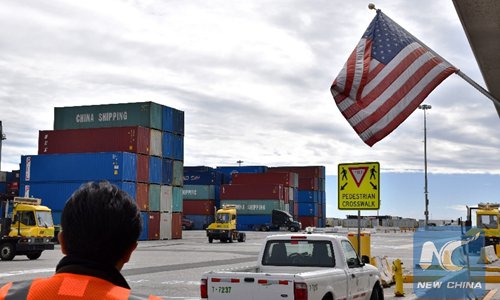HOME >> SOURCE
Declining US-China trade trend hard to reverse
Source:Global Times Published: 2019/12/9 22:26:19

Photo:Xinhua
It has been 18 months since the US began imposing 25 percent tariffs on the first tranche of Chinese goods, and bilateral trade between the world's two largest economies is still sliding. The General Administration of Customs showed that China's trade with the US fell 11.1 percent year-on-year to 3.4 trillion yuan ($483 billion) in the first 11 months of this year, widening from a 10.6-percent decline in the first 10 months.Even with a "phase one" trade deal, the downtrend in bilateral trade will be difficult to reverse. Meanwhile, China's total trade actually expanded 2.4 percent year-on-year in the first 11 months, indicating that trade with the US is not irreplaceable for China.
As the tariff war dragged on, Chinese companies sought new suppliers from other countries and explored the sales potential of the domestic market. Their hard work explains why China's trade with its major partners (except the US) showed marked gains during the first 11 months - enough to make up for the decline in China-US trade.
Specifically, in the January-November period, China's trade with the EU, the country's largest trading partner, jumped 7.7 percent. Trade with the Association of Southeast Asian Nations, the No.2 partner, rose 12.7 percent.
Some in Washington may claim that the US has finally managed to narrow its trade deficit with China, as customs data showed that China's trade surplus with the US hit 1.88 trillion yuan in the first 11 months, narrowing 3 percent on a yearly basis.
It is true that a trade war could affect US-China trade and reduce the US trade deficit with China to a certain extent, but as long as Americans maintain low savings, the country's overall trade deficit won't change. Instead, some of the deficit with China will turn into deficits with other countries like India and Vietnam.
As for US consumers, they are bound to bear higher costs, regardless of whether manufacturers in China stay put or move production out of China under US tariff pressure. It's impossible for the US to benefit from such industrial transfers as virtually no price-sensitive manufacturing work will go back to America.
In addition, the trade war is rearranging the global supply chain by affecting the global trade environment. This development is beyond the control and expectations of the US.
For instance, regarding the industrial chain in East Asia, China used to import intermediate goods from Japan and South Korea, and assemble them into finished consumer goods for export to the US.
Now, as China exports less to the US amid the trade war, it also imports less from Japan and South Korea. Customs data showed that from January to November, China's imports from Japan fell 2.4 percent and those from South Korea dropped 12.9 percent.
So the rest of the world will have to restructure their industries and prepare for the reorganization of the world's value chain as result of the US-triggered tariff war.
Posted in: GT VOICE